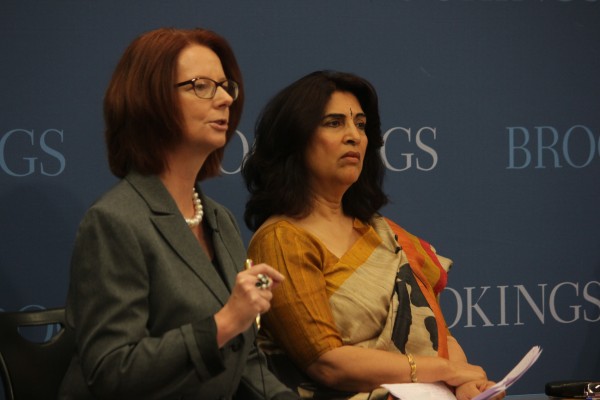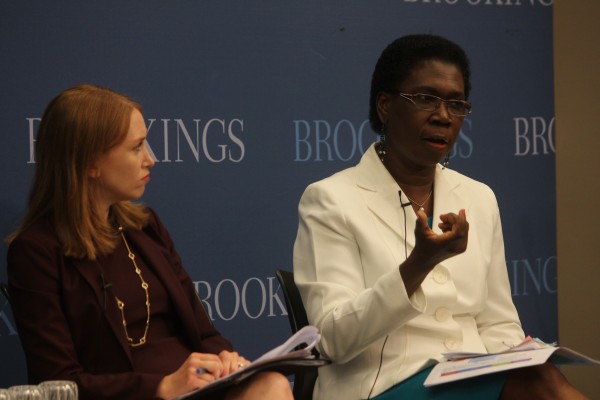
Former Prime Minister of Australia Julia Gillard moderates a discussion at the Brookings Institution about empowering girls through education. The panel included Urvashi Sahni, the founder and chief executive of the Study Hall Education Foundation in India. (Erin Bell/SHFWire)
WASHINGTON – Globally, 30 million girls don’t get a basic education, according to the Center for Universal Education at the Brookings Institution.
Isabel Matenje, a gender and social development specialist who is married to the ambassador of Malawi to the U.S., was one girl who got the opportunity to pursue an education. In fact, she was the only girl at her school who didn’t drop out.
“I happened to go to a secondary school that was in a district where my dad came from and that was kind of the rural district,” Matenje said. “I was working very hard, being advised by my parents that I needed to succeed. The other girls’ parents weren’t helping them to understand what education was all about.”
Experts in women’s education said Tuesday at the Brookings Institution that it is important for girls and their families to see the value in educating girls and empowering them to feel entitled to an education.
Less than half of girls in low-income countries were enrolled in primary school in 1990. That figure has climbed to nearly 80 percent today. According to a 2012 American Community Survey, about 6 percent of the U.S. population has less than a ninth-grade education. About 8 percent haven’t finished high school.

Rachel Vogelstein, director of women and girls programs for the Clinton Foundation, left, and Patience Stephens, special adviser on education for U.N. Women, discuss why girls don’t always finish school and what can be done about it. (Erin Bell/SHFWire)
Erin Murphy-Graham, associate adjunct professor at the Graduate School of Education University of California, Berkeley, said making schooling available isn’t enough to continue that growth internationally. The root cause of why girls aren’t in school needs to be addressed.
“Girls don’t believe they are entitled to education,” Murphy-Graham said. “They’ve come to believe that they’re inferior because the messages that they are receiving from society are that they are inferior.”
According to a 2013 report by the United Nations Educational, Scientific and Cultural Organization, most countries with high levels of disparity in access to both primary and secondary education are in sub-Saharan Africa. The Central African Republic has made no progress in getting girls in school and has the second highest level of gender disparity in the world after Afghanistan.
The same report also showed that two-thirds of illiterate adults around the world are women, a figure that has remained largely unchanged for over two decades. In the U.S., about 14 percent of the population is illiterate, according to a 2003 report by the National Center for Education Statistics.
Interviews done by Girls’ Education Challenge, which tracked 40,000 girls around the world through their education, showed that most of the parents were supportive of girls’ education, Sally Gear, who leads the program, said.
“However, tradeoffs came in,” Gear said. “For example, household chores of up to six hours in one case, or where the fees were limited, and the choice was made that the boys would go to school,”
So, empowerment becomes important.
Study Hall Educational Foundation, in Gomtinagar, Lucknow, India, makes empowering girls one of its missions. Founded by Urvashi Sahni for disadvantaged girls, Study Hall is a co-educational secondary school.
“The empowerment program finds quickly that if you’re trying to get girls to come to school, if you’re trying to get them to stay and learn, and most importantly if you’re trying to make a difference in their lives, then it can’t be business as usual, it can’t be what you’ve been doing all along,” Sahni said. “We had to look at all the problems being a poor girl in India brings with it.”
Students often faced sexual violence at home and on the streets, child marriage and child labor. Sahani’s school teaches an empowerment curriculum, incorporating conversations about the girls’ lives and critical feminist pedagogy. Now the school has more than 1,800 students.
Sahni drew on her own experiences to start the school. She was married off soon after high school, even though she was middle-class and went to a high-quality Catholic school. She eventually finished college.
“It didn’t give me a sense of entitlement, didn’t give me a sense of feeling equal,” she said. “Schools need to look and these things and support girls.”
_____
Editor’s note: This story was previously published on the Scripps Howard Fundation Wire.

